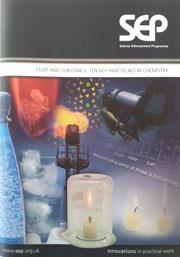Penny Bagshaw reviews this booklet of practical activities
Stuff and substance: ten key practicals in chemistry
Philip Johnson
London, UK: Gatsby Science Enhancement 2011 | Pp60 | Free | ISBN9781907168093
Reviewed by Penny Bagshaw

This booklet provides a valuable addition to any secondary school science department’s resource library. It focuses on explaining the concept of a substance, the conditions under which substances can change state and how substances can take part in chemical reactions to make new substances. Reference is also made to previously published e-learning resources, freely available from the National STEM Centre eLibrary.
The content is organised in two main sections: ideas and suggestions for using the material in the classroom followed by teacher and pupil sheets for the ten practical activities. I believe that teachers should find the first section of greater use, being thought-provoking, and challenging assumptions that even some experienced science teachers may have. For example, pupils may believe that solid, liquid and gas are three different types of material rather than interconvertible states of the same substance. The distinction between the macroscopic level (substance) and the particle model level (atom) is made with a clear flowchart of the ten experiments, observations and explanations. The ideas behind each experiment are described in detail. Accompanying photographs and diagrams can be downloaded from the website to create presentations.
Teacher notes for each experiment are comprehensive, including learning objectives, practical and safety tips and resources needed. I was less impressed by the pupil worksheets. Clear diagrams and hazard warnings are shown on the right hand side of each page and instructions on the left. However the instructions are rather lengthy and wordy, which would be a challenge for some pupils in the 11-14 age-range targeted. They also combine references to teacher demonstrations and pupil experiments which could be confusing.
Ready-made pupil materials are always tempting to busy teachers, but I believe the best use of this booklet would be to clarify ideas about important concepts (and likely misconceptions) relating to substances, changes of state and chemical reactions. Teachers could then tailor the pupil materials more closely to their own needs.
Related Links
Stuff and substance: ten key practicals in chemistry
Access this book via the National STEM Centre






No comments yet